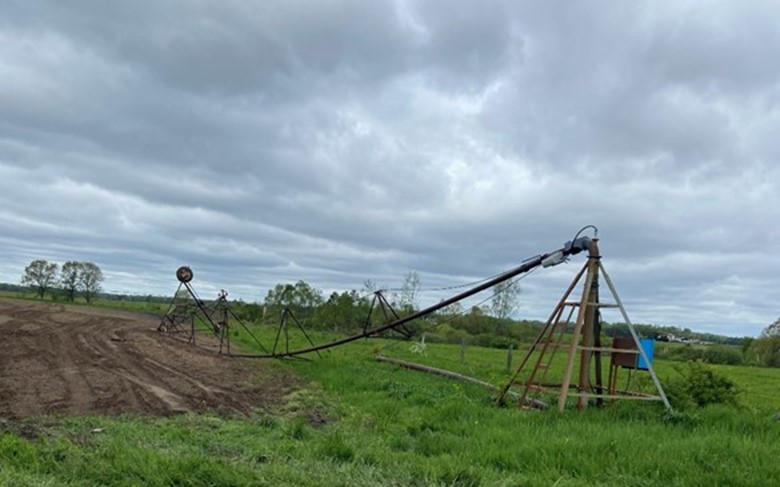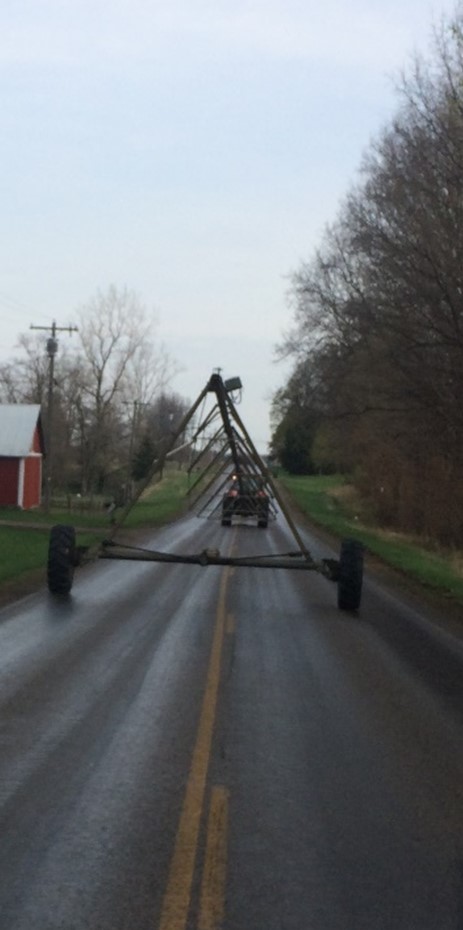Does your insurance cover damage to irrigation systems?
Understanding coverage options, filing a claim, and whether your policy covers your farm needs.

Recent storm events are a reminder of how much damage can happen to irrigation equipment. For most irrigators, purchasing insurance is a way to avoid financial disaster.
Many high-value specialty crop contracts require equipment to be insured, and sometimes total replacement value is required. Specialty crops can run into values exceeding $1 million per 100-acre field. Companies requiring insurance hope an all-new pivot can be put up quicker if insurance is paying for it, which salvages the crops for the year and replaces the damaged equipment.
A sign in a local insurance company says, “You must own it to insure it,” which is a reminder that the owner of the equipment is the person who needs to acquire the insurance. This issue came to light when recent storm events significantly damaged irrigation equipment. In at least one field where the center pivot was destroyed, the pivot was found to have no insurance from either the lessee or the landowner. Another term for no insurance is self-insured, meaning that the total cost for the replacement would be absorbed by the irrigation owner. In the previous field example, if the irrigation equipment was owned by the lessee, they would be responsible for the purchase of insurance or paying to replace the irrigation system.
Insurance companies will require listing the components the coverage is issued against and an estimated value. Irrigators need to remember that electronic items and wells have a high likelihood of damage. Variable frequency drive control boxes, wells and their motors, which are all items that have high potential for lightning damage.

Insurance for irrigation equipment can be purchased as part of a farm owner’s policy by listing the center pivot, wells, pumps and controls as farm equipment. Irrigation-specific insurance is often sold through equipment leasing agencies and irrigation equipment suppliers. These irrigation-specific insurance policies are often used with leased equipment or as part of a package deal with the purchase of a complete system under an equipment loan. Producers need to make sure when using irrigation-specific insurance policies that they are not double insuring any individual piece of equipment. Likewise make sure pumps, generators, disconnect panel or other equipment are covered even if they are not part of the system lease.
Choose the coverage options that best fit your needs
Coverage options vary between insurance providers, but commonly fall into the following categories:
- Comprehensive Coverage: Provides protection against all types of covered losses, often including mechanical breakdowns, weather-related damage, theft, and vandalism.
- Named Peril Coverage: A customizable policy option that allows selection of specific risks to be insured against. Often considered a more cost-friendly coverage option, irrigators can align coverage with major areas of risk exposure.
- Replacement Cost Coverage: In situations of a total loss, producers receive the full amount needed to replace the pivot system with a new, comparable unit.
- Actual Cash Value Coverage: Provides reimbursement for damaged or lost pivot system based on its current market value. Adjusted by the depreciation of the existing system, there is often a lower payout compared to replacement cost.
Consider any cropping contracts that you are committed to when choosing the level of insurance coverage for the irrigation system. Some contract provisions may leave you liable for crop losses if you do not replace equipment quickly enough to prevent damage.
Key questions to identify if equipment insurance coverage meets farm needs
- Is an irrigation system held by individuals or the business itself? Whomever owns the system gets the check.
- Does the policy have a current equipment list, or does it need updating? Outdated equipment lists could mean replacement systems are only partially covered or not at all.
- Does coverage offer repair, full replacement or lowest cost options? If supplies are tight, the answer may limit how quickly irrigation systems can be up and running in a field.
- Is there any debt against equipment that affects coverage? Lenders often work with producers to replace damaged equipment. Just make sure they know what’s going on with insurance payments.
- If equipment is covered by both liability and equipment policies, can one be reduced without increasing risk?

Avoid the confusion between liability coverage and equipment insurance. The operator of the equipment should have liability coverage for the equipment he runs and maintains. Liability insurance protects against risks of liabilities imposed by lawsuits and similar claims involving the irrigation system. Irrigation equipment depends on automated controls, often runs on high voltage electricity and has no operator present most of the time they are running. All these factors have an inherent risk involved.
Key questions to identify if liability insurance coverage meets farm needs
- What is at risk besides damaged equipment and can the farm withstand those losses without coverage? Coverage should meet farm needs and adversity towards risk.
- Are certain farm practices covered under the policy? Certain activities may limit or disqualify a farm from liability protection.
- Is there any debt against equipment that affects coverage? Lenders may have similar conditions for how both liability and equipment insurance payments are handled. If there’s debt on the irrigation system, always keep lenders up to date on repairs or replacement progress.
Another consideration should be what happens to yield losses if an irrigation system fails. Equipment insurance usually only covers irrigation systems and their components. If there is a yield loss, producers will need to rely on crop insurance to make up any differences.
Key questions to identify if crop insurance coverage meets farm needs
- How do insurance units affect potential yield losses? The likelihood of payments can change between units: enterprise (whole crop), basic (share of production) or optional (individual sections).
- What practice type (i.e., irrigated, non-irrigated) are farm acres covered under? Less than normal water applications on irrigated acres could lead to yields that trigger a loss payment.
- Is the farm’s insurance company aware of irrigation damage and the potential of resulting yield losses? Failure of irrigation water supply is a covered loss for many insurance policies. Letting agents know of irrigation failure can help with insurance claim processing if there is a loss.
Steps for filing a claim
- Document the loss or damage. Take pictures or videos of the damaged areas. At a minimum, maintain these documents throughout the claims process. The insurance company may provide additional instructions on how long to keep documentation beyond the process itself.
- Collect policy numbers and other relevant policy documentation before calling to file a claim. Review the farm’s insurance policies to understand what type of coverage exists.
- Contact your insurance agent to report the claim. If they are unavailable, contact your insurance company’s claims hotline, if available. At the time of the call, be sure to ask if there are any questions about insurance policies.
- Document discussions or interactions with the insurance company and/or adjustors. Track any emergency damage repair and associated receipts. Take additional pictures after any repairs for before and after damage comparisons. The State of Michigan’s Department of Insurance and Financial Services (DIFS) has created a document to track this information with. The tracking sheet can be found at: DIFS Insurance Claims Tracking Sheet.
- Take any additional steps to protect the property and prevent further loss, if possible. If additional supplies are needed, keep receipts for any purchases for inclusion in the claims process.
For additional steps to aid in filing a storm damage claim, check out the Irrigation Storm Damage Checklist.
Producers should meet with their respective insurance agents to review policy coverage. Make sure everything an agent says is fully understood by all farm managers. Be sure to ask questions related to risk scenarios and how coverage would work.
Special thanks to William Hendrian, MSU Extension District 8 Director, for input on liability insurance considerations.



 Print
Print Email
Email